Setting up your store to comply with German laws
Every country has its own set of requirements the online businesses must comply with. If you run your online business in Germany, you need to make sure your online store meets those of your country.
Your online store has the necessary features that will help you set up your store so it complies with German laws. To have access to all of these functions, make sure that a German address is set as your company address in the Allgemein → Shopprofil section in your store admin.
This guide doesn’t claim to be complete and contains the common guidelines for online trading. We recommend getting advice from legal professionals to take into account the specifics of your business.
1. Add legal information
Add your store policies in your store admin and assign them to your site navigation.
Legal pages
You are required to display the legal information concerning delivery, privacy policy, terms of service, etc. in your store so that every visitor can have quick access to them from any site page. Here is an example of terms and conditions in German. You should contact your legal advisor to get the necessary legal documents.
You can put the text of legal documents into the legal pages in the Einstellungen → Rechtliches section in your store admin:

As a result of such a setup, the links to legal pages will automatically appear at the bottom of your Instant Site if you use it for your website. Also, the links to the enabled legal pages will be attached to customer notifications that your store sends to buyers, for example, to Order Confirmations.
If you use another sitebuilder, you’ll need to add the links to your legal pages to a menu on your website manually.
Here is how you can get the links to the legal pages added in your store admin:
- Enter your Instant Site and scroll to the bottom for the links to the legal pages that you’ve enabled in your store admin (Einstellungen → Rechtliches).
- Click on a legal page link and check your browser address bar. Each page will have its own ending. For example, the privacy policy page has the ending /pages/page=privacy-policy.
- Copy the link.
- Open the store page in your website.
- Get the URL from your address bar and append the copied part to it. You will have the URL to your privacy page in your online store.
You can now include the copied links of legal pages to your website navigation, for example, to a footer menu or a sidebar.
Below you can find the instructions on how to add a footer menu with legal pages links in different sitebuilders as well as display a footnote about Lieferzeiten:
In cm4all sitebuilder
- Open your website editor.
- Click the footer area of the site to start editing the text.
- Enter the anchor of the links to the necessary legal pages.
- Select the added text, so the editor toolbar appears.
- Choose the right font and formatting for these links.
- Select the anchor text for each link.
- In the editor toolbar click the link icon and set the URL of the link to that particular page (see the instruction above).
- For a footnote for Lieferzeit attribute, click the area where you’d like to put the footnote. You can either add the text to the footer to display it on every site page or put it below your store widget to display it only on the store pages.
Add the following text: *Gilt für Lieferungen innerhalb Deutschland. Lieferzeiten für andere Länder finden Sie hier.
Select the hier word in the added text, click the link icon in the editor toolbar and add the link to your Versandkosten page in store.
If you offer express shipping methods, your Lieferzeit attribute might say: Standard max. 5 Tage, Express 1 Tag* .
In this case, the footnote should be: *Gilt für Lieferungen nach Deutschland bei Standardversand. Bei Expressversand gilt eine Lieferzeit von 1 Tag innerhalb Deutschlands. Lieferzeiten für andere Länder und Informationen zur Berechnung des Liefertermins siehe hier.
Again, select the hier word, then click the link icon in the editor toolbar and add the link to your Versandkosten page in store.
In WordPress
- Сreate a new menu:
- In your WordPress admin area, go to Appearance → Menus.
- Create a new menu for your legal pages.
- Copy the URLs for the links to each legal page on your website if you added legal pages in your store admin (see the instruction above).
- Use the Custom Links area to add each link into the menu.
- Once the menu is ready, save it and add to your site footer or sidebar:
- Go to Appearance → Customize → Widgets.
- Select a footer area or sidebar.
- Click on Add Widget.
- Choose Navigation menu from the list and select your custom menu with links to legal pages.
- For the Lieferzeit attribute, in the Appearance → Widgets drag the Text widget into the footnote area.
Add the text of your footnote: *Gilt für Lieferungen innerhalb Deutschland. Lieferzeiten für andere Länder finden Sie hier.
Select the hier word in the added text, click the link icon in the editor toolbar and add the link to your Versandkosten page in store.
If you offer express shipping methods, your Lieferzeit attribute might say: Standard max. 5 Tage, Express 1 Tag*
And then the footnote text should be:
*Gilt für Lieferungen nach Deutschland bei Standardversand. Bei Expressversand gilt eine Lieferzeit von 1 Tag innerhalb Deutschlands. Lieferzeiten für andere Länder und Informationen zur Berechnung des Liefertermins siehe hier.
Link to OS-Platform (online dispute resolution)
According to one of the European directives, every European trader should provide a clickable link to the platform for online dispute resolution (so-called “OS-platform”) where the trader and a customer could try to resolve their disputes about online purchases out of court.
To meet this requirement, just add a short description and a link to the OS-platform in the About us page (Einstellungen → Rechtliches).
Here are the examples:
- In English:
Platform of the EU Commission regarding online dispute resolution:
http://ec.europa.eu/consumers/odr - In German:
Plattform der EU-Kommission zur Online-Streitbeilegung:
http://ec.europa.eu/consumers/odr
Right of Return expiration for digital products
If you sell digital products, your customers are eligible to return purchases within 14 days for a full refund unless they have started downloading or streaming digital goods.
If you would like to avoid refund requests for the digital products purchased in your store, you may want to ask your customers for a consent to the expiration of the right of return when a digital item is purchased.
To enable this option in your store:
- From your store admin, go to Einstellungen → Rechtliches.
- Scroll down to the Zustimmung der Kunden section.
- Activate the Hinweis auf eingeschränktes Rückgaberecht für digitale Produkte anzeigen option:

When this option is turned on, the corresponding mandatory checkbox is shown on the checkout page in your store. Your customers will need to give their consent by ticking off this checkbox in order to proceed with checkout:

2. Display tax information
Add information about VAT that will be charged (or won’t be charged) so that customers can see it during shopping in your catalog.
VAT in your catalog
You need to include tax information on your product pages, i.e. display total product price saying it includes VAT:

In your store, you can choose to enter prices with taxes included (gross prices) or without taxes included (net prices). Gross prices already include VAT. If you use net prices, VAT tax will be added on top of the price that you enter in your store admin.
You can choose how you enter your prices by clicking Preiseinstellungen ändern in the Einstellungen section on the Einstellungen → Steuern & Rechnungen page in your store admin.
When it comes to tax amounts, there are 2 ways you can set up taxes in your store — automatic and manual taxes.
To set up taxes in your store:
- From your store admin, go to Einstellungen → Steuern & Rechnungen.
- Choose what applies to you:
- If you sell products with a standard tax rate, you can simply enable automatic tax calculation. After that your store will automatically calculate the tax using the standard rate of your country.
The system will check your customer location based on their IP address and will automatically show prices as tax inclusive in your catalog to customers from the EU. - If there is more than one tax rate in your store, you need to choose the manual tax setup, set up different tax rates and then assign the necessary tax to each product manually.
To assign a certain tax rate to a product, go to Produkte → Produkte, click on a product, then click the Steuern und Versandkosten tab and enable the proper tax rate(s) for this product.
- If you sell products with a standard tax rate, you can simply enable automatic tax calculation. After that your store will automatically calculate the tax using the standard rate of your country.
Now the product pages in your store provide your EU customers with information about total product price including tax. If you’re displaying the Buy Now buttons in the product list, the Preis inkl. MwSt. (Price incl. VAT) line will appear there, too:

Learn more about EU taxes (VAT).
VAT- exemption for small businesses (special case)
If you are a small business owner and your turnover is not big, you may not be required to collect and pay VAT. However, the law obliges small business owners to notify their customers about their special tax status.
To enable such notification in your store, proceed to Einstellungen → Steuern & Rechnungen and enable the option Ich bin Kleinunternehmer gemäß § 19 UStG:

After you enable this option, the corresponding note will appear on the product details pages in your store:

Enabling this option does not affect the actual tax calculation process in your store. You must separately configure the way the taxes are calculated and displayed in your store, here are the instructions on how to set up taxes.
If you no longer meet the criteria for getting the special tax status and are obliged to collect VAT, set your tax rates in Einstellungen → Steuern & Rechnungen and disable the Ich bin Kleinunternehmer gemäß § 19 UStG option.
Tax invoices
You can generate tax invoices for your orders both manually and automatically and attach them to Order confirmation emails. These tax invoices are legally compliant and meet the standard invoicing requirements for the EU. There are two types of tax invoices available in your store admin: regular invoices for your sales and cancellation invoices for your refunds.
To preview an invoice that can be generated in your store, go to Einstellungen → Steuern & Rechnungen → Rechnungen → Inhalt der Rechnung (the preview is available if the invoices are enabled in your store).
You can always create a tax invoice for an order in your store admin, on the page of the order in Verkäufe → Bestellungen:
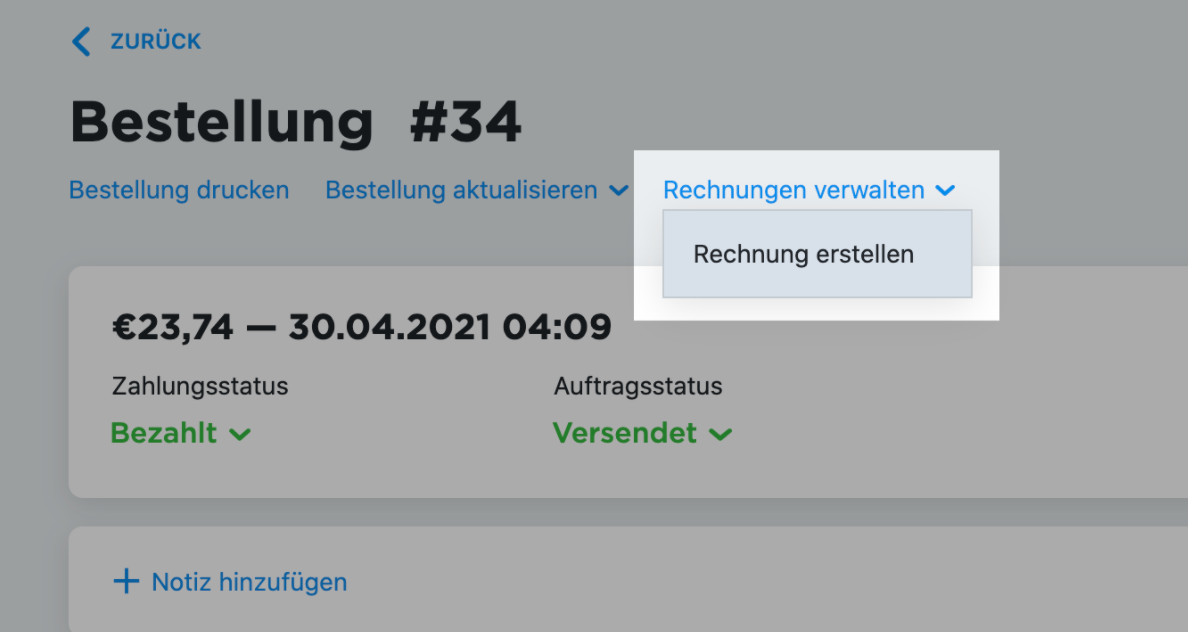
All the invoices that have been created for a particular order are available in the Rechnungen section on the page of this order. If needed, you can also download all the invoices for a certain time period in bulk.
If you have some specific requirements for invoicing or if you are making invoices via a third-party system outside of your store, you can turn off tax invoices in Einstellungen → Steuern & Rechnungen.
Learn more about creating tax invoices →
3. Display shipping information
You should inform your customers about shipping costs and delivery time frames in your catalog.
Shipping costs in your catalog
If you charge shipping costs in your online store, you must inform your customers on every product page that additional shipping costs apply:

Your store automatically displays the zzgl. Versand (Excl. Shipping) notice linking to your shipping policy if:
- You have added at least one shipping method in the Versand und Abholung section of your admin.
- Your products require shipping.
- You have enabled the Versandkosten & Zahlungsinformationen legal page in the Einstellungen → Rechtliches section of your admin.
If you’re displaying the Buy Now buttons in the product list, the zzgl. Versand notice will appear there, too:
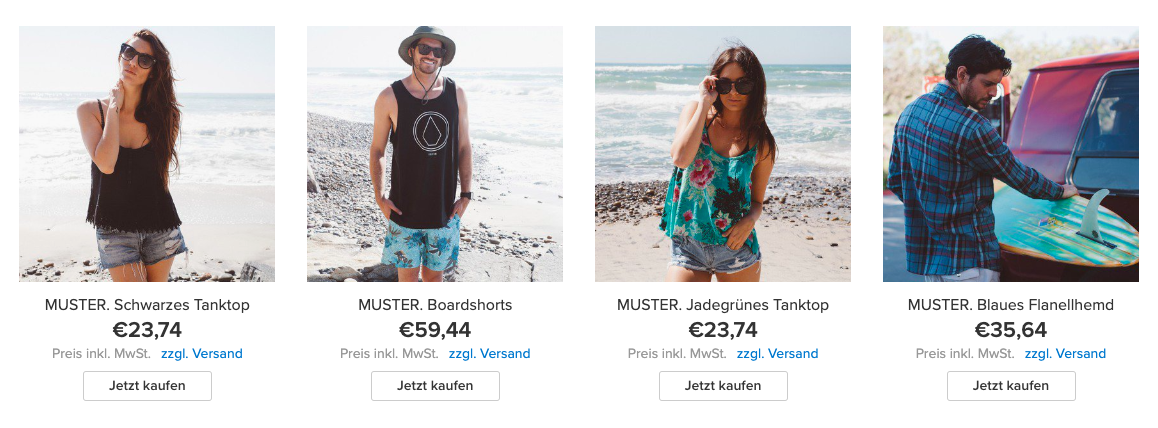
Delivery time in your catalog
The product detail page must provide information about an estimated delivery time for each product. This will make it easier for your customers to decide to purchase from you, especially if you offer express mail options or self-pickup that you can highlight on a product page.
If you run your online business in Germany, an estimated delivery time appears automatically on a product page once you specify it in your shipping settings.
If you are on a Free plan, you can put this information either in the product descriptions or in an attribute’s text field that appears above description on product pages.
4. Display important information about products
Include the list of essential product properties and characteristics to your product pages.
Essential product characteristics
The product detail page must provide information about the essential characteristics of the product. This will make it easier for your customers to decide what product to purchase.
You can use product attributes to show the list of characteristics on your product pages:
- Go to Einstellungen→ Produktsorten and create product types for different kinds of products that you sell. If you sell products sharing the same properties, you can use the General product type, it is a default one.
- Add attributes for your product types (for example, Material and Color for Clothes type).
- Enter the values for product attributes to display them on product pages:
- Go to Produkte → Produkte.
- Open a product.
- Open the Eigenschaften tab.
- If you use different product types, click the [ Art ändern ] link and choose the appropriate product type for the product.
- Enter the values in the attribute fields for the product.
- Save the changes and repeat it with other products.
After you add the product attributes values for your products, these characteristics will show in the Product page, the Cart page, and the Order Confirmation page for the respective product.
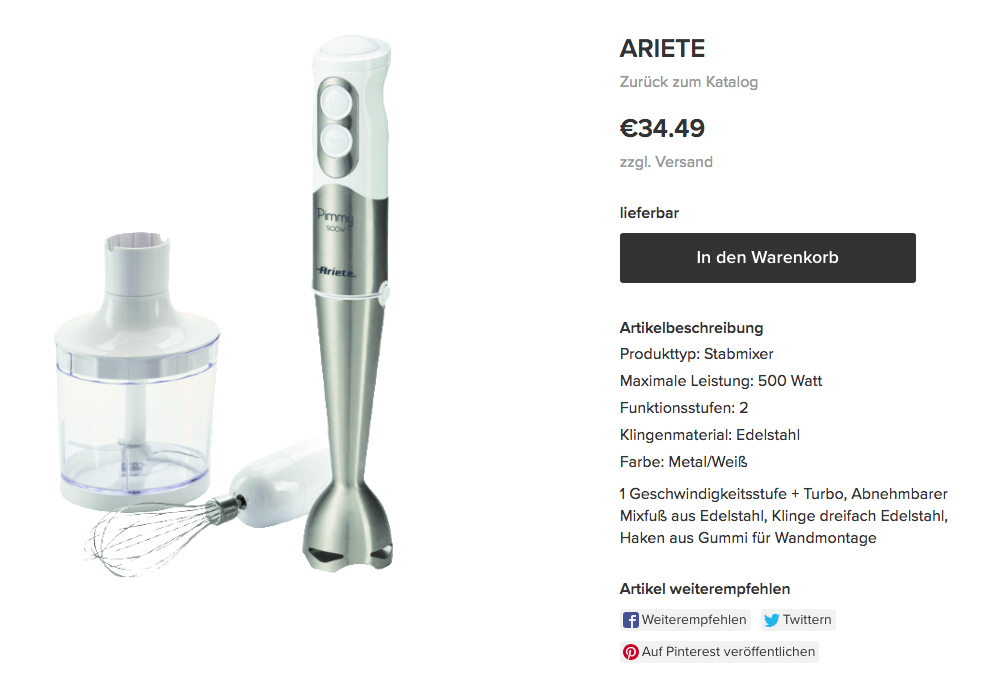
Price per unit
If a product can be measured in units such as kilograms, liters, meters, you need to specify the exact price for that unit of measurement in your store.
To specify price per unit:
- Go to Einstellungen → Allgemein → Warenkorb page and enable the Einzelpreis anzeigen option.
- Navigate to Einstellungen → Produktsorten. The price per unit fields appear there now (for each product type):

- Add product types for different kinds of products that you sell:
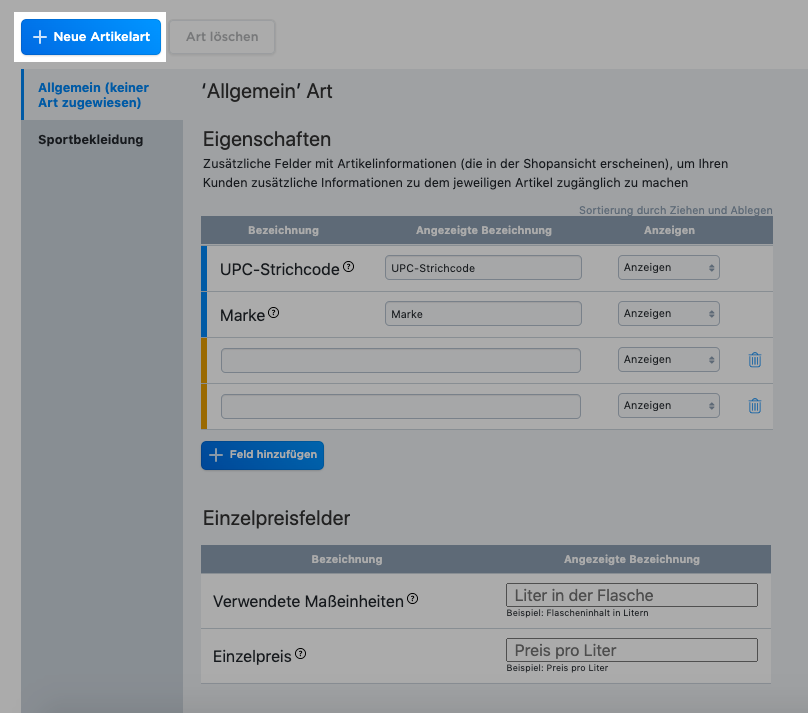
You should have one product type for liquid products (beer, juice etc.) measured in liters and a different product type for products measured in kilograms (cheese, nuts, etc.)
Prices in the Einzelpreis field must be calculated as per meter (€/m), kilogram (€/kg), square meter (€/m²), or liter (€/L).
- Enter the display names in the Verwendete Maßeinheiten (e.g. Liter in der Flashe for “Drinks” product type) and in the Price per unit fields (e.g. Preis pro Liter).
- Show the price per unit fields on product pages:
- Go to Produkte → Produkte.
- Open a product.
- Open the Eigenschaften tab.
- Click the [ Art ändern ] link to choose the appropriate product type for this product.
- Enter the values in the price per unit fields — click the dropdown button next to the product price in the price editor and enter the necessary values to the corresponding fields (make sure that the price per unit also includes all applicable taxes):

- Save the changes.
After that the entered price per unit will display in the product page for customers:
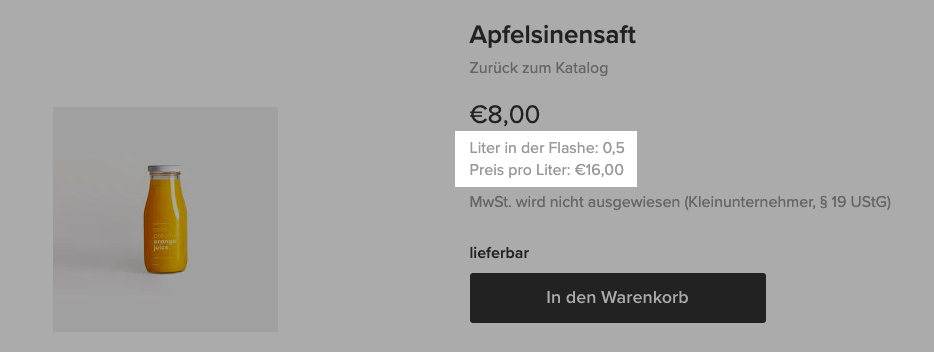
You can set individual price per unit values for your product variations if needed (go to the
Optionen → Kombinationen tab).
Energy labels and product data sheet
If you sell energy-consuming products in your store (household electrical appliances, electric lamps, etc), you are obliged to show the energy labels and the data sheet for such products. You can use the Energy Labels app to comply with these law requirements and provide your customers with the necessary information about your energy-consuming products.
After you install the Energy Labels app in your store, you will see a detailed instruction on how to add energy labels and product data sheet in your store admin, Produkte → Energielabels:

5. Enable customer privacy settings
You should request consent from your customers to use their private information.
Ask for permission to use personal data
You may need to use your customers’ email addresses for different store purposes such as sending them news about your catalog or passing their email addresses over to a delivery company when fulfilling their orders.
The customer’s email address is considered a personal data, which means you must receive explicit permission from customers to use their emails. To request such permission from your store customers, you can use a special checkbox in the checkout page of your store.
To request the permission from customers to use their personal data:
- From your store admin go to Einstellungen → Allgemein → Warenkorb.
- Scroll down to the Newsletter block.
- Activate the Holen Sie die Zustimmung Ihrer Kunden zum Erhalt Ihrer Marketing-E-Mails an der Kasse ein option.
- Enter your text in the Labelbeschriftung field.
- Save the changes.
After you activate this option, the corresponding checkbox will display at checkout, under the e-mail address input field:

If a customer gives the permission to use their email, you will see this information in their order details in store admin, Verkaufe → Bestellungen:

Get customers’ consent to use cookies
You can display a banner on your storefront asking for a customer’s consent for tracking data through cookies. The banner appears once a customer starts browsing the website, and doesn’t disappear until they make a selection. The customer data is only tracked if they click Accept:

To enable the cookie consent banner in your store:
- From your store admin, go to Einstellungen → Allgemein → Tracking & Analysen.
- Scroll down and turn on the DSGVO Cookie-Einverständnisbanner.
- Save the changes.
We recommend checking the default text on the banner and updating it to your needs. For example, you can use the following text:
Our website may use Facebook Pixel and cookies for statistical purposes and to track how our marketing activities on Facebook are recorded and improved. Similarly, we may use Google Analytics to monitor the activity on our website. Information on Facebook Pixel, Google Analytics, cookies, and your right to object can be found in our Privacy Policy.
To update the banner’s text you cann use the Storefront Label Editor app: go to Einstellungen → Textlabels Bearbeiten and set a necessary content for the Notice.TrackingConsent.description label.
6. Display important notices at checkout
You can show important information for your customers at checkout. For example, if the customers are outside of the EU, some extra charges like custom duties may appear.
Adding such notes to your store is possible with the help of the Checkout notices app. The app allows displaying any text in the cart and checkout pages.
If the note contains the information about extra charges (e.g. import customs duty), we also recommend adding this information to the Order confirmation email. You can change the notification template in your store admin, Einstellungen → Benachrichtigungen.